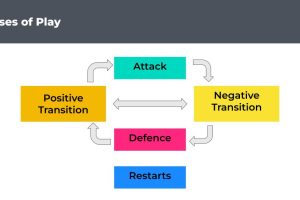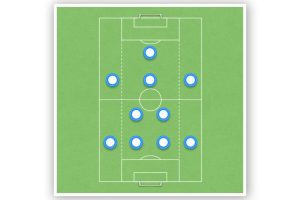Soccer Headers: Risks and Benefits of the Aerial Game
Soccer headers are an iconic move in soccer and an essential skill for any player. A header can be used to pass the ball to teammates and even help score goals. However, mastering the technique requires great body control, strength, accuracy, and endurance.
Although headers are an advanced skill, there are various drills and exercises that players can practice to improve their technique. These drills focus on torquing the neck, using the forehead area to hit the ball, and jumping high to push the ball in the intended direction.
Despite the importance of headers in soccer, there has been growing concern about the potential risks associated with frequent and forceful heading. Some studies suggest that repeated heading may lead to brain damage and cognitive impairment. As a result, there have been calls for increased education and training on proper heading technique, as well as guidelines to limit the frequency and force of heading in youth soccer.
What are Soccer Headers?
Soccer headers are a technique used in soccer where players use their head to control the ball. This technique is used to pass, shoot, or clear the ball from a standing, jumping, or diving position. Headers are a common technique used by players in practically every match, and they can be used in both offensive and defensive situations.
Headers require a combination of power and accuracy to be successful. Players must use the right amount of force to make contact with the ball and direct it towards their intended target. Additionally, technique is crucial when executing a header. Players must position their body correctly and use the right technique to make contact with the ball.
Headers can be an effective way to score goals, especially when the ball is crossed into the penalty area from a corner kick or free kick. However, headers can also be dangerous if not executed properly. Research has shown that heading the ball can increase the risk of concussions, so it is important for players to use proper technique and protective headgear to reduce their risk.
Overall, headers are an important and often-used technique in soccer. They require a combination of power, accuracy, and technique to be successful, and they can be used in both offensive and defensive situations. While they can be dangerous if not executed properly, with the right technique and protective gear, headers can be a valuable tool for players looking to score goals and control the ball.
The Importance of Soccer Headers
Headers are an essential part of soccer, and they can be used both in offense and defense. A header is a technique used to control or direct the ball using the head. While it may seem like a simple maneuver, headers require a great deal of skill and precision. In this section, we will explore the importance of soccer headers and how they can impact the game.
In Offense
Headers are often used in offense during corner kicks, free kicks, and crosses. A well-executed header can result in a goal, providing a significant advantage to the team. Players who are skilled in heading can control the ball with precision and accuracy, increasing the chances of scoring. Headers can also be used to maintain possession of the ball, allowing the team to control the pace of the game.
When a player is attempting a header, they must read the trajectory of the ball and make a decision to jump or stand and head. Good headers of the ball focus on the flight of the ball more than the movement of teammates or opponents. Eyes should be open at contact, and the ball should be contacted by the forehead between the eyebrows and hairline.
In Defense
Headers are also critical in defense, where they can be used to prevent the opposing team from scoring. A well-timed header can clear the ball from the danger zone and prevent the other team from gaining control or taking a shot. Defenders who are skilled in heading can also use this technique to intercept passes and regain possession of the ball.
When a defender is attempting a header, they must be aware of their position and the position of their teammates and opponents. They must also be able to judge the speed and trajectory of the ball accurately. A poorly executed header can result in an own goal, providing an advantage to the opposing team.
Overall, headers are an essential part of soccer and can impact the game significantly. Players who are skilled in heading can control the ball, maintain possession, and score goals. Defenders who are skilled in heading can prevent the opposing team from scoring and regain possession of the ball. It is essential for players to practice and master this technique to become successful in soccer.
The Risks of Soccer Headers
Short-Term Risks
Heading a soccer ball can cause immediate short-term risks, such as concussions and neck injuries. A poorly executed header, where two players hit heads, can cause a concussion. A concussion is a type of traumatic brain injury that can cause headaches, dizziness, confusion, and memory problems. In addition to concussions, heading can also cause neck injuries, such as strains and sprains. These injuries can be painful and limit a player’s ability to move their neck.
Long-Term Risks
Long-term risks of heading a soccer ball are still being studied, and the research is not yet conclusive. Some studies suggest that repeated heading may cause brain damage over time, while others have found no evidence of long-term damage. However, some studies have shown that heading can cause issues with memory, attention, and reaction speed in soccer players who do a lot of headers. It is important to note that most of these studies have been done on professional players, and it is not clear if the same risks apply to amateur or youth players.
There are also concerns that heading a soccer ball may be more dangerous for certain groups of people. For example, children may be more vulnerable to head injuries than adults because their brains are still developing. Some experts have also raised concerns that players with larger heads may be at greater risk of injury, as they may experience more force when heading the ball. Additionally, players with weaker neck muscles or poor balance may be more likely to suffer a head or neck injury when heading the ball.
Overall, while the risks of soccer headers are still being studied, it is clear that there are both short-term and long-term risks associated with this skill. Players should be aware of these risks and take steps to protect themselves, such as practicing proper technique, using protective headgear, and monitoring their symptoms after a head injury.
How to Practice Soccer Headers
Practicing soccer headers is an essential part of developing a player’s skills. It requires a combination of accuracy, technique, and balance. In this section, we’ll cover some basic drills to help players improve their headers.
Drill #1: Directional Headers
One of the most important aspects of a header is the direction in which it is headed. To practice this skill, players can use a partner or a wall. The player should stand a few feet away from their partner or wall and toss the ball in the air. The objective is to head the ball in a specific direction, either left, right, or straight ahead. This drill can be repeated several times to improve accuracy.
Drill #2: Corner Kick Headers
Corner kicks are an excellent opportunity for players to practice their headers. The objective is to head the ball into the goal. To practice this drill, players can set up cones to represent the goal posts and have a teammate take a corner kick. The player should position themselves in front of the cones and attempt to head the ball into the goal.
Drill #3: Kneeling Headers
Another drill to improve balance and technique is kneeling headers. The player should kneel on the ground and have a partner toss the ball in the air. The objective is to head the ball accurately and with power. This drill can be repeated several times to improve technique and balance.
Drill #4: Heading Through Cones
Heading through cones is a great drill to improve accuracy and technique. The player should set up cones in a line and stand a few feet away from them. The objective is to head the ball through the cones without knocking them over. This drill can be repeated several times to improve accuracy and technique.
Practicing soccer headers is crucial for any player looking to improve their skills. By using these basic drills, players can develop accuracy, balance, and technique, and become more confident in their ability to head the ball.
Conclusion
Heading the ball is an essential skill in soccer. It helps players to score goals, defend against them, win the ball back, and keep possession. However, it is important to note that heading can also lead to concussion symptoms. According to a study by CNN, heading is involved in only 15% to 25% of concussions in soccer, and most of those are a result of player-to-player and player-to-ground contact.
Coaches can help their players become more comfortable with heading by using soccer header drills. Soccermodo provides a list of six effective drills that can help players become less timid and have more fun while heading the ball. The more comfortable players get at it, the better they will ultimately be at heading.
It is also important to note that too many headers in a game can lead to failed concussion tests. According to The Guardian, players in League Two have headed the ball more than 20 times in a match on 58 occasions in a season. This figure declines higher up the football pyramid but even in the highest levels of the game, players are still at risk of suffering from concussion symptoms.
Overall, while heading is a crucial aspect of soccer, it is important for coaches and players to understand the risks involved and take necessary precautions. By implementing proper training techniques and adhering to concussion protocols, players can continue to enjoy the game while minimizing the risk of injury.








